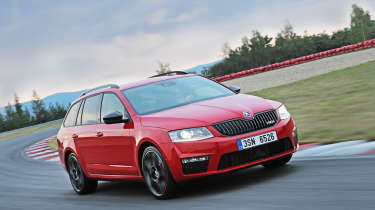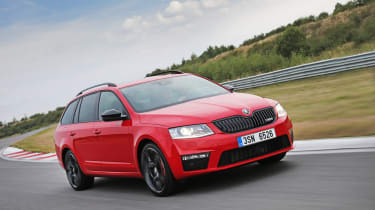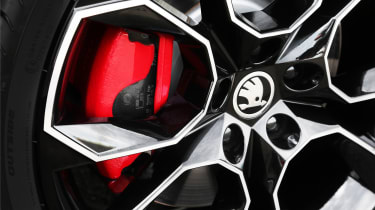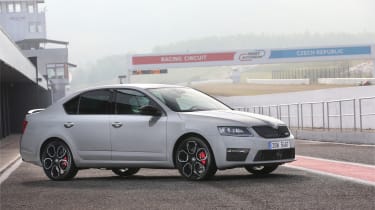Skoda Octavia vRS 230 review - most powerful vRS ever
Fastest Skoda vRS ever tops the range and is the Octavia to go for
Skoda’s most powerful vRS car to date, and its fastest too, the Octavia vRS 230 joins the current Octavia line-up and sits at the top of the tree, with an additional 10bhp over the standard petrol vRS. It’s also equipped with an electro-mechanical limited-slip diff and will be available as a hatch or estate with either a six-speed manual or DSG gearbox.
The 2-litre turbocharged four-cylinder engine now produces 227bhp (up from 217bhp) 200rpm higher in the rev range, from 4700rpm through to 6200rpm. Torque remains at 258lb ft, although it’s available for longer, from 1500 through to 4600rpm.
Performance has improved, but you’ll need a sensitive backside to feel the 0.1sec drop in 0-62mph time (now 6.7sec for the manual, 6.8sec for the DSG hatch models and 6.8sec and 7.0sec for the respective estate variants). There’s also a 1mph increase in top speed, to a limited 155mph, for the hatch, and 153mph and 152mph for the estate with a manual or DSG gearbox respectively. The vRS 230 also gets an electronically controlled mechanical limited-slip differential as standard.
The chassis is the same as the regular vRS’s, with the hatch sitting 12mm lower and the estate 13mm lower than a regular Octavia. Nineteen-inch ‘Xtreme’ alloy wheels are standard fit and wear a 225/35 tyre.
Externally the vRS 230 is distinguished by black door mirrors and front grille, standard xenon headlights, a black gloss finish to the exhaust tips and ‘Sunset’ rear glass; estate models also get black roof rails. Inside, electric heated leather sports seats are standard as are an Amundsen touchscreen satnav system, an auto-dimming rear-view mirror and park assist.
More reviews
In-depth reviews
Long term tests
- Skoda Octavia vRS (Mk4 facelift) Fast Fleet test – living with the £40,000 Q‑car
- Skoda Octavia vRS Estate (Mk4) Fast Fleet test – living with the practical performance estate
Reviews
- Skoda Octavia vRS 2025 review – the ultimate accessible Q car?
- Skoda Octavia vRS iV plug-in hybrid 2020 review – eco stealth
- Skoda Octavia vRS Estate review – the perfect balance of practicality and performance?
- Skoda Octavia vRS 245 review - the hottest Octavia gets hotter
- 2017 Skoda Octavia vRS review - bigger and cheaper than a Golf GTI, but better?
Prices for the new vRS 230 start at £26,150 for a manual hatch, rising to £28,540 for a DSG-equipped estate: a £2520 increase over all standard vRS models. The vRS 230 is the equivalent to the Performance Pack offered on Volkswagen Golf GTI.
Technical highlights
The electronically controlled mechanical diff is the highlight of the car. A multi-plate clutch unit, it can deliver up to 100 per cent of the engine’s torque to the front wheel with the most grip and traction. Two settings are available – Normal and Sport – that can be switched via the vRS Mode button on the centre console.
The diff is largely the same unit you will find in the Volkswagen Golf R’s Haldex clutch four-wheel-drive system, but without the additional driveshafts. The clutches close when the forces build and torque needs to be distributed between the front wheels. As well as providing greater traction and control through a corner, the diff is also designed to improve stability under acceleration on wet or low-grip surfaces. The standard ESC and traction control systems can only be partially switched off.
The 2-litre turbocharged engine gains its 10bhp increase through an ECU remap and a new sports exhaust system that includes new front and rear silencers and a reduction in back pressure.
While the chassis and brakes remain the same as on the standard vRS (as does the electro-mechanical power steering), the larger standard wheel and tyre combination provide an increased tyre foot print and, consequently, more grip. The combination of the diff, the remap and more mechanical grip has resulted in the vRS 230 being around ten seconds a lap quicker over the 12.94-mile lap of a certain German race circuit.
What’s it like to drive?
On the track (Skoda chose to only have a track driving element for the vRS 230’s international launch), the power advantage is undetectable, but the manual gearbox certainly gets the best from the power unit, which pulls strongly with no turbo-lag to speak of. The shifts of the optional DSG are just too slow, the ’box being particularly tardy to react on downshifts, often leaving you in the wrong gear as you turn in, or changing down as you’re about to clip an apex.
In the slower corners of the circuit the diff does an admirable job of supressing understeer, but ultimately the inside driven wheel can still be felt spinning up as the outer tyre begins to be overwhelmed as you open the throttle.
However, in faster, third and fourth gear corners, the vRS 230 can be hustled into a turn and will resolutely hold its line, running to corner exit with a more controlled and measured attitude than the standard car. The natural push you’d expect from a front-driven chassis (Skoda hasn’t eliminated understeer, despite its claims) is more linear and progressive than in a car without a diff, allowing you to feed in the throttle as the nose passes the apex, which allows for a clean and quick exit. The 230 is no track car though, and we’ll have to wait a week or two until we get to drive an example on the road before we can draw a firm conclusion.
For now, however, if you were about to order a vRS, we’d spend the extra and opt for a vRS 230. The cost of adding the 230’s standard Sunset glass, electrical and heated sports seats, touchscreen satnav and park assist to a regular vRS would push the price up by £2450, which makes the £2520 premium the 230 commands look a bit of bargain. Especially when you consider that it also includes the larger wheels, an engine upgrade, and a new exhaust and diff.







